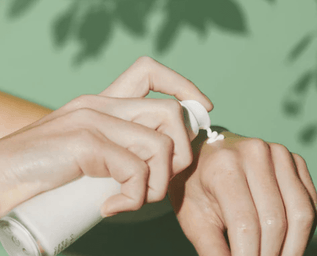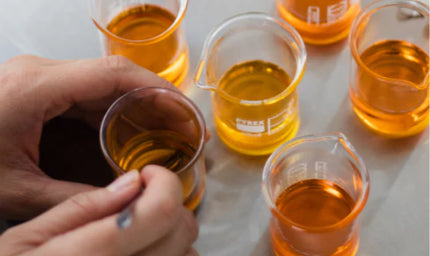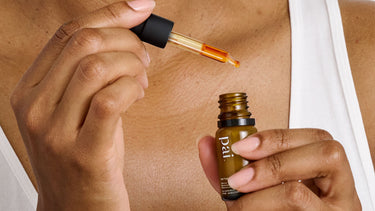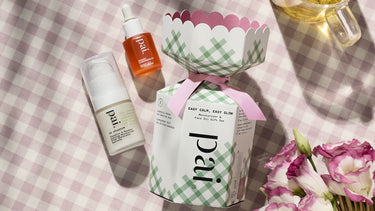If there’s one thing you could say to our Founder, Sarah, to really push her buttons, it’s that natural and organic products aren’t effective. Try it, and brace yourself for a sincere and impassioned explanation of just how wrong you are. And while any organic skincare brand creator might argue the same, in our case we’ve proved it time and time again – and never more so than with our collection of skincare boosters.
These little brown bottles of highly potent actives launched in 2021, proudly arriving with a trio of ingredients that we knew our customers were crying out for. Two years down the line, we’re launching our seventh in the range – Salicylic Acid. Our first BHA, and our first to target the needs of blemish-prone skin.

Our dynamic drops weren’t about jumping on a skincare trend. As with most Pai innovations, they came from Sarah’s deep understanding of what it’s like to live with sensitive skin day in, day out – and the things it holds you back from. Because we firmly believe that sensitivity should never mean missing out.
“We knew we had a lot of customers with sensitivities that wanted to incorporate more actives into their routine, but were too fearful - either because of previously bad experiences, or because of not wanting to disrupt an existing regime that was working for them,” says Sarah, who created Pai following her chronic urticaria diagnosis. “Our boosters collection was the answer to that.”

Finding a winning formula
We started with the concept: these boosters had to be in-demand, effective ingredients that support the skin as it ages. They had to be certified natural or organic, obviously. And they had to be affordable – because this was about giving our customers the power to personalise their existing routine, instead of forking out on products that might not suit them.
“By their very nature, boosters allow our customers to dip their toe into actives with confidence,” explains Sarah. “They get to feel in complete control. They can blend just one drop into their moisturiser and build from there, supercharging their existing products in the specific way that their skin needs at the time. It’s an affordable route, allowing them to have multiple boosters in their armoury to pick from.”
The difference between ours and others on the market? The benefits come from 100% natural ingredients. “Many actives like Peptides have traditionally been 100% synthetic. We have found extraordinary sources of the same active materials in plants, with none of the irritating side effects – and no compromise on performance,” says Sarah. In fact, the Collagen we use was proven in tests to perform as well as, or even better, than its animal-derived counterparts*.
Focusing on one ingredient doesn’t make formulation simple, though. “High concentrations of actives are difficult to formulate,” admits John, our Head of R&D. “The main issue is stability, although each one has its own unique characteristics with its own difficulties. Safety and suitability for sensitive skin is another factor, and of course the most important for Pai.”

The team started with some of the most science-backed actives on the market – Vitamin C, Peptides, and Prebiotic Inulin. Later came Vegan Collagen, Hyaluronic Acid and Tri-Mushroom; highly-requested, newly-trending ingredients that we knew would be a hit for those with sensitive skin.
Now Salicylic Acid joins the party – and it may have been the trickiest one to create yet.
“Salicylic Acid is difficult to solubilise; most formulators use alcohol or propylene glycol to solubilise it,” John tells us. “We try to avoid these types of ingredients, but to make it the best it can be, we have had to use organically-sourced alcohol to ensure it does not crystallise out of the product – as it will not provide a skin benefit in crystal form. And we would never compromise on efficacy.”
While alcohol is commonly used by other brands, it added complications for the production team in our London-based lab.
“Contact with air had to be reduced to a minimum during the manufacturing process,” explains Katarzyna, Pai’s Production Manager. “We had to achieve a transparent and smooth texture as well as preventing alcohol evaporation, which meant the filling process and timing had to be strictly monitored.”
Talking of texture, keen shoppers might notice a difference between the original boosters and the newer arrivals. With the first batch, the focus was on finding the optimum texture – not too gloopy, not too runny, but just right – so that they would drop and blend into your skincare seamlessly. The result was successfully serum-like for the water-based formulations, while our Stabilised Vitamin C felt like a lightweight, non-greasy oil.

For this year’s launches, the team implemented a new manufacturing method to make our boosters feel even more sophisticated.
“Now, a small oil phase is heated in the main vessel and the preheated water phase is poured on top,” says Katarzyna. “This was a new process, but our technicians adapted it well which has resulted in the unique texture of our newer boosters.”
A question of concentration
Behind the scenes, there was also a fiery debate about the concentrations. Browse other single-active products on the market, and you’ll find it’s a numbers game. Bottles are plastered with percentages next to the ingredient names, and naturally, you’d assume that higher equals more effective – right?
Well, not quite. Our cosmetic chemists shed light on the murkier side of impressive-looking stats. “A 5% active could perform better than a 10% active in a more effective formulation,” says John.
“Some manufacturers declare the percentage in terms of the amount of active material added to the formulation. This is correct, assuming the material is 100% active – which is not always the case. If it isn’t, then the active is over-declared, which is misleading to the consumer.”
After weighing up the pros and cons, we decided to keep the percentages on our booster labels. While we knew other brands on the shelves might appear deceptively higher, our commitment to transparency was more important.
“The simple truth is that the beauty industry doesn’t have any rules on how to declare percentages of actives,” explains Sarah. “So there is huge inconsistency. Just like there are a lot of overstated claims on green credentials (called green- and clean-washing), there’s a lot of percentage-washing too!”
What matters is that what’s inside our boosters is potent – and the concentration is optimised. “All of our actives are included at the highest recommended levels with proven efficacy, as determined by both the suppliers and the labs. There’s no ‘dilution’; they are working at their optimum levels,” says Sarah.
“But declaring these actives transparently and honestly means they don’t compare favourably with competitors, who are fudging the numbers to compete for the highest (albeit fake) number.”
True to our values, we also ditched the complex jargon. Each active simply states what its core skin benefit is, making them easy to navigate online and in store. And that little brown glass bottle? It’s designed to protect what’s inside – meaning you get the best quality product from the first drop to the last.
A breakout breakthrough
On, then, to the decision to launch Salicylic Acid – a beta hydroxy acid for blemish-prone skin that has strict limitations on how strong it can be without a prescription – and one that often poses problems for sensitive skin. “Those with sensitive skin tend to avoid using AHAs and BHAs, as we are worried about the risk of irritation or dryness,” explains Rhea, Pai’s Senior NPD Product Manager.
We wanted to push the boundaries and target a skin issue that is often forgotten by other brands. Many common actives used in the treatment of spots, such as Benzoyl Peroxide, are harsh on the skin, causing imbalances and further problems.
“We have all experienced dry, flaky skin around a blemish which can be as visible as the blemish itself,” says Sarah. “So we wanted to offer a solution in our booster format that addresses both.”
By choosing a well-established exfoliating acid that’s known for digging deep into the pores to clear them out, we knew we could tackle breakouts. And finding a natural source was a no-brainer (ours is a combination of White Willow Bark and Wintergreen, at the highest strength of 2%). But by putting it into a booster, we’re putting you in charge. Dot it onto blemishes as a spot treatment, or blend a drop with your existing skincare to ease in slowly if you’re on the sensitive side.

You’ll know by now that every Pai product goes through rigorous patch testing to prove it’s suitable for sensitive skin. But we’ve also gone the extra mile to make this formula even kinder, cushioning it with organic Glycerine, Chamomile Water, and Prebiotic Inulin – to help calm and increase skin resilience.
“During breakouts, skin carries a lot of redness, soreness and inflammation which you need to tackle alongside the blemishes themselves,” adds Sarah. “Doing this will speed up the spot’s healing time and overall skin’s recovery.”
A boosted booster, if you will. And while we’re thrilled to announce this new arrival, we’re not stopping there. Watch this space for more well-known actives that are proven to work, yet are often problematic for sensitive skin. Because if anyone knows how to deliver effective, science-backed ingredients in a gentle, certified natural way, it’s us.
Shop our boosters collection today to supercharge your skincare
*4-week efficacy study of AC Vegetable Collagen PF



















































